Master of Detail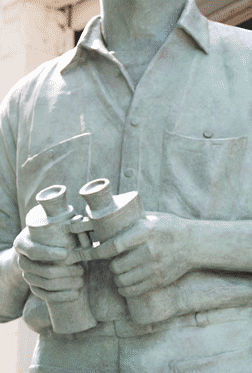
Maryland Sculptor Toby Mendez Honors another Chesapeake Icon
story by Ben Miller, photos by Cathy Conway Miller
Binoculars in hand, a sailor, Marine or Coast Guardsman looks out toward Chesapeake Bay. Larger than life and forged of bronze and copper, this statue honors our veterans. These veterans fought not in Iraq or Afghanistan. These men trained at Solomons during World War II to land on the beachheads of Europe and the Pacific Islands.
Since 1998, Calvert Marine Museum’s Cradle of Invasion reenactment has commemorated this chapter in history. This year, On Watch, by sculptor Antonio Tobias Mendez, rises as a permanent monument, dedicated on August 11 as the final event of this year’s tribute.
Honoring Heroes
Toby Mendez’s work has honored other heroes in Chesapeake Country. Walk around the state government buildings at Lawyers’ Mall in Annapolis. You’ll see Mendez’s sculpture of the young attorney Thurgood Marshall, who used the courts to break down the walls of racial segregation, with figures of the young law student and the children his landmark cases benefited. Hurrying through the Baltimore/Washington International Thurgood Marshall Airport, you’ll see Mendez’s bust of an older Marshall, the U.S. Supreme Court Justice.
At the old Wiley H. Bates High School in Annapolis — now a senior center, retirement home and boys and girls club — you’ll see Mendez’s bust of Bates, the Annapolis businessman and philanthropist who contributed to the first black high school in Anne Arundel County.
For Annmarie Garden, the sculpture garden in Solomons, Mendez created A Tribute to the Oyster Tonger, A Chesapeake Waterman. Mendez captured the stance and demeanor of the waterman and his boat so well that many local visitors say, That looks like my grandfather.
Sports fans may have seen his sculpture of Hall of Fame baseball pitcher Nolan Ryan on television. The eight-foot-tall figure stands in front of the Texas Ranger baseball stadium in Arlington, Texas.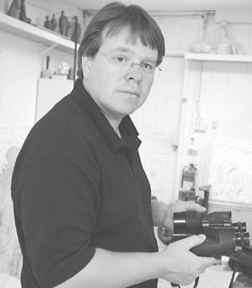
An Artist’s Work
Toby Mendez is young looking at 43. He has a quiet, composed presence.
His gallery and studio, Pleasant Valley Studios, is tucked away amidst trees and flowers at the base of Elk Ridge in Washington County, Maryland, not far from the Potomac River and Harpers Ferry. In this quiet place, Mendez creates monumental public sculptures, portrait sculptures and small figures.
The gallery is saturated with color with displays of his work, paintings by his father, Antonio Joseph Mendez, and photographs by his stepmother, Jonna Mendez.
Mendez grew up with art. His late mother, Karen, was an interior decorator. Mendez was born in Denver. His father’s work with the Central Intelligence Agency took him as a boy to Okinawa and Bangkok, but Mendez considers himself to be a product of the Maryland school system. He began sculpting in middle school and graduated from Boonsboro High School near Hagerstown. He credits high school art teacher Dennis Sherald with giving him the confidence to make his living as an artist.
After high school, Mendez worked as a sculptor with the make-up artist John Chambers, known for the movie Planet of the Apes. In 1988, he graduated from the School of the Art Institute of Chicago, where he learned to sculpt and cast bronze figures. He spent a year in Madrid assisting the Spanish sculptor Jose Cobo produce a public monument.
A Multitude of Skills
A sculptor has many skills. Mendez supports himself through public commissions and private sales. He is an artist and, by necessity, a businessman.
He is disciplined. Mendez works a regular schedule like the rest of us. He comes to the studio from his home in Frederick, arriving about 9am and working until about 5:30pm. On deadline, he’ll work 12-hour days to complete a project.
He is an engineer. He inserts metal rods in his clay models, but large bronze sculptures seven to eight feet tall and 800 to 1,000 pounds must support themselves. An outstretched arm could break off like a tree limb if the sculptor miscalculates.
He knows physiology, the science of the body, to make his figures real. Mendez studies anatomy books. He takes as many as 100 measurements of his models’ bodies to capture the reality of muscles, torsos, arms, legs and facial features. He photographs his models from all angles. Since outdoor figures must be larger than life (if made at actual size they look too small), he must extrapolate the measurements to a properly proportioned seven- to eight-foot-tall statue.
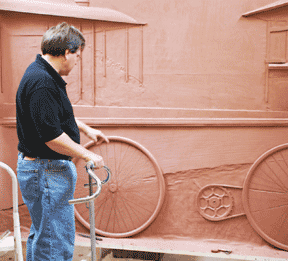
Getting It Right
Mendez is a master of detail. He does his own historic research. In libraries and archives, he studies photographs of clothing, stances and equipment. For On Watch, Mendez bought World War II binoculars through eBay to make sure his figure carried an accurate pair. He learned that early in World War II, sailors did not have standard work clothing. In photographs, sailors are wearing different shoes, belts and dungarees. Uniforms were standardized later in the war.
He learned to research while working on his first public commission for the Navy Memorial in Washington, on Pennsylvania Avenue near the National Archives. You would expect the Navy to supply the reference information, but this was not the case. The Naval officers knew the details of their time in the service, but Mendez found if he was depicting a Korean War scene, such as a helicopter landing on a ship, he had to convince the brass that his version was accurate.
“I could substantiate every decision that was made,” Mendez said.
Far from interfering with his creativity, this meticulous research informs his artistry. The “homework,” he says, “brings out elements of the design.”
Mendez is applying this attention to detail to the project now in his studio, a figure of Marshall ‘Major’ Taylor, an African American bicyclist who won international championships in the early 1900s. He will stand in front of the library in Worcester, Massachusetts, where Marshall lived as an adult. To create this larger-than-life sculpture, Mendez photographed and measured an African American cyclist who specializes in sprinting, like Marshall. A sprinter’s leg muscles develop differently than those of a long-distance cyclist such as Lance Armstrong.
Son of the Master of Disguise
Toby Mendez’s father, Antonio Joseph Mendez, was a model, not only for his creativity, but also for his attention to detail.
Known as the Master of Disguise, the elder Mendez worked for the Central Intelligence Agency as the man in charge of creating false identities, forging passports and papers and creating ruses for undercover agents and Russian defectors. His most well-known exploit, described in his book Master of Disguise, My Secret Life in the CIA, written with Malcolm McConnell, was in spiriting six American diplomats out of Teheran, Iran, during the takeover of the American embassy in 1979.
The six had taken shelter in the Canadian embassy, where they were hidden by the diplomats. Mendez created false identities for the Americans, posing them as a Hollywood film crew in Iran to film a documentary. Mendez actually created a film company with scripts, artwork and ads in a movie industry newspaper. He gave the Americans forged documents, taught them cover stories and provided disguises to change their appearance. The ruse was spectacular and unexpected. Dressed in flamboyant clothing befitting movie people, the six walked through the Teheran airport, passed through customs and flew home to freedom.
Casting a Bronze Sculpture
In his studio, Mendez sculpts his figure in clay. The clay figure completed, he takes it to a foundry. For On Watch, he used the New Arts Foundry in the Hampden section of Baltimore. This foundry specializes in art and art restoration, not industrial production, though the processes are similar.
The artists and artisans transform Mendez’s full-size clay model into a bronze and copper statue. They use the lost-wax process, making a rubber mold of the original, a wax copy from the mold, coats of stucco to create another mold and, finally, molten bronze heated in a crucible and poured into the stucco mold. New Arts Foundry’s skilled workers smooth the imperfections created during casting.
Mendez relies on the foundry artisans to create a permanent bronze sculpture true to his original. The final stage is selecting the color, called the patina. Mendez chose a blue-green patina for On Watch, similar to that of The Oyster Tonger at Annemarie Garden. The sculpture, Mendez said, “will go to green, anyway, because of the salt air” of the Chesapeake.
On July 31, Mendez and his sculptor-assistant Gavin Gardner drove a flatbed trailer to Baltimore to pick up the seven-foot-tall, 1,000-pound sculpture to drive it down Route 4 to Solomons.
Making a Monument
Mendez created On Watch in about a year, with the sculpting taking two to three months and casting at New Arts Foundry three to four months. The project began years earlier with Karen Stone and Sherrod Sturrock of the Calvert Marine Museum and Calvert County Commissioner Linda Kelley, all involved in the planning. They and others wanted to permanently honor the brave men who trained to take the landing craft onto the beaches.
The statue cost $100,000, and the total project costs an additional $40,000. Contributors are the state of Maryland, which passed a bond bill for its half of the statue; the Koenig Foundation, the group behind Annmarie Garden; the Calvert County Board of Commissioners; Dominion Cove Point LNC, the liquefied natural gas port and storage facility that is Calvert’s second largest employer; Landing Craft Infantry;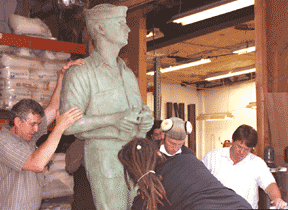 and hundreds of donors who bought commemorative bricks. and hundreds of donors who bought commemorative bricks.
Matt Gambrill of Calvert Marina provided the site and paid for the design of the base by COA Inc., and the site preparation and base construction by Marrick Properties. The Pagliaro Brothers, stone masons of Upper Marlboro, helped install the sculpture.
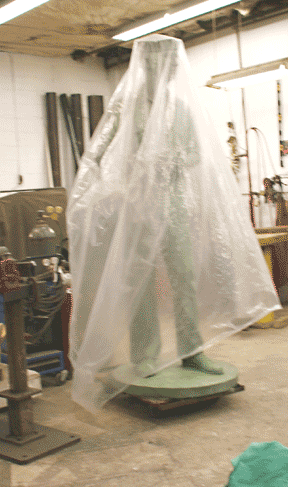
An Artist’s Skill
After all the stages of fundraising, sculpting and casting, the success of the sculpture comes down to the artist’s skill. Mendez’s sculptures aren’t real. They are made of bronze, after all. His sculptures don’t startle you like figures in a wax museum. But in a way they are more than real. Look at them closely, and they speak to you.
Toby Mendez’s sculptures convey movement with an upraised hand, emotion with parted lips, power with a lifted chest and vitality with active eyes. Standing frozen for all time, they speak of the life and energy of another time and keep our memories of that time alive.
A Lasting Tribute
You can see On Watch on Saturday or anytime after. The sculpture stands at the end of Dowell Road on the grounds of Calvert Marina.
Mendez had as his model a young man, Jason Seibert, originally from Clear Spring, Maryland, and the son of Tim Seibert, the model for The Oyster Tonger. But you would swear his model was a sailor from 1942, young but serious, standing relaxed but alert, staring out from shore or from a bridge of a ship, looking for hazards or the enemy — or perhaps a distant shore.
Events beginning at 10am include exhibits, a driving tour of Solomons, lectures and demonstrations by the United States Marine Corps Historical Company, recollections by veterans, a Cradle of Invasion cruise on the Wm. B. Tennison and dedication of On Watch at 5pm: 410-326-2042; www.calvertmarinemuseum.com
|
